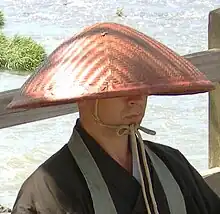笠
| ||||||||
| ||||||||
Translingual
Han character
笠 (Kangxi radical 118, 竹+5, 11 strokes, cangjie input 竹卜廿 (HYT), four-corner 88108, composition ⿱𥫗立)
References
- KangXi: page 880, character 7
- Dai Kanwa Jiten: character 25924
- Dae Jaweon: page 1308, character 3
- Hanyu Da Zidian (first edition): volume 5, page 2959, character 2
- Unihan data for U+7B20
- Unihan data for U+F9F8
Chinese
| trad. | 笠 | |
|---|---|---|
| simp. # | 笠 | |
Glyph origin
| Historical forms of the character 笠 | |
|---|---|
| Shuowen Jiezi (compiled in Han) | Liushutong (compiled in Ming) |
| Small seal script | Transcribed ancient scripts |
 |
 |
Characters in the same phonetic series (立) (Zhengzhang, 2003)
Phono-semantic compound (形聲, OC *ɡ·rɯb) : semantic 竹 (“bamboo”) + phonetic 立 (OC *rɯb).
Etymology 1
Compare Proto-Tai *klɤpᴰ (“bamboo hat”) (Schuessler, 2007).
Pronunciation
Synonyms
Dialectal synonyms of 斗笠 (“Asian conical hat”) [map]
Compounds
Pronunciation
Definitions
笠
Japanese

笠
Readings
- Go-on: りゅう (ryū)←りふ (rifu, historical)
- Kan-on: りゅう (ryū)←りふ (rifu, historical)
- Kun: かさ (kasa, 笠)
Etymology
| Kanji in this term |
|---|
| 笠 |
| かさ Jinmeiyō |
| kun’yomi |
From Old Japanese, from Proto-Japonic *kasa (“cover, hat”). Cognate with Miyako 笠 (kasa), Okinawan 笠 (kasa), Yaeyama 笠 (kasa). Related to 傘 (kasa, “umbrella”).
Korean
Vietnamese
This article is issued from Wiktionary. The text is licensed under Creative Commons - Attribution - Sharealike. Additional terms may apply for the media files.